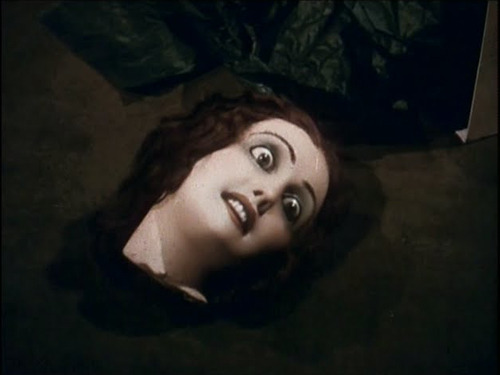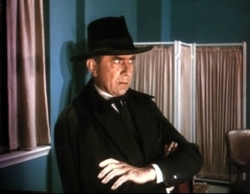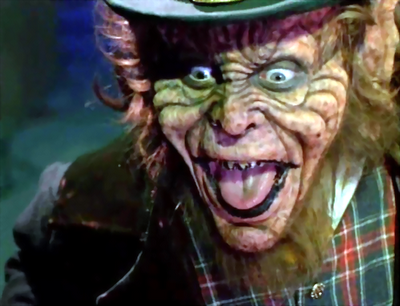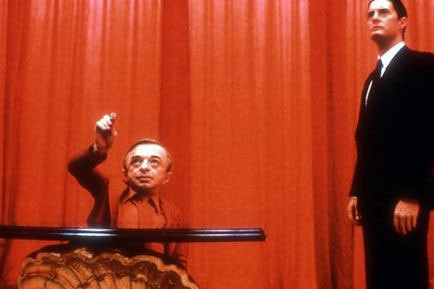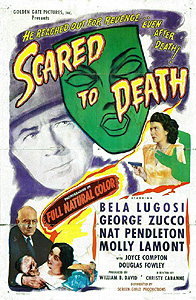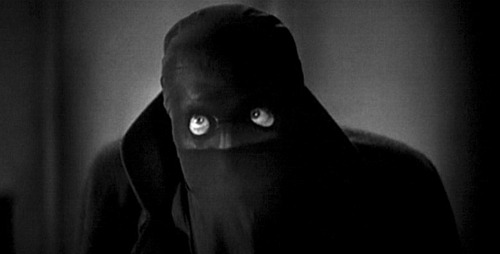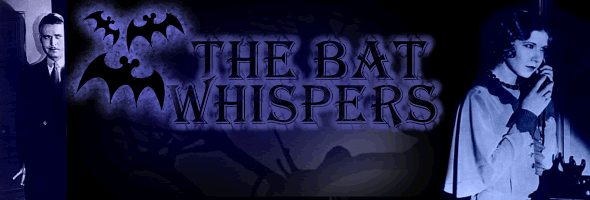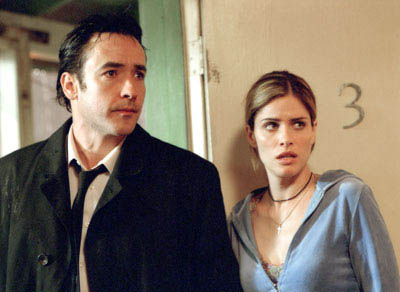Incurable insanity.
Dying unloved.
Carnies.
These things scare the RDHP to death. But a floating blue mask?! That sure doesn’t water our pants!
Yet it sure does a number on Laura Van Ee, our easily scared stiff heroine in this week’s film, “Scared to Death.”
Talking from a cold morgue slab, Laura Van Ee relates to the audience the bizarre tale of how she died… literally scared to death!Love and marriage go together like a horse and carriage, right? Well, not in the Van Ee home. There they go together more like cutting and hemophilia. Laura Van Ee and her husband Ward hate each other’s guts, but Laura refuses to grant a divorce. Why? Cause this is the 1940s, and Laura’s never worked a day in her life (or has she?!?!?! Foreshadowing here people). Without a husband, how would she feed and clothe herself, she cries!
Laura and Ward live with Ward’s father, Dr. Joseph Van Ee, who hates his daughter-in-law more than Casey Anthony hates motherhood.
Dr. Joseph and his sonny-boy start to conspire to get rid of Laura, but don’t get far before the mysterious Professor Leonide – Dr. Joseph Van Ee’s estranged cousin – barges into their home. Fresh off a stay in a Nazi concentration camp, Leonide and his midget companion return to the Van Ee home where Leonide also grew up hoping to mooch off Dr. Joseph. Seems Leonide needs a place to crash while he gets his midget enhanced hypnosis act off its feet in the States (possibly, the plot was murky on why Leonide showed up).
Once Leonide arrives, all hell breaks loose. Laura starts getting grave warnings about her impending death, and even stalked by a floating blue mask. Her nerves are set on the brink… made worse by her mysterious fear of blindfolds and inability to reveal details of her past life prior to marrying Ward Van Ee. But don’t worry, a bumbling idiot private eye is on the case, hoping to solve a murder mystery and earn his way back on the police force he was thrown from. Add in a nosy reporter that shows up looking for a story and you have a packed nut house.
The scares keep building, Laura’s nerves keep fraying, and somewhere Leonide’s midget dances.
Who is trying to kill Laura?If a tree falls in the woods, does it make a sound?
Find out, in this week’s 1947 Technicolor nightmare, “Scared to Death.”
RDHP Ratings and Review
C-Rating: 2.0
Chris Dimick hypnotizes:“Thanks for the downward spiral, Bela!
Let me explain. You gotta feel bad for Bela. In the 1930s, he is the pointy teethed king of horror, receiving top billing in A-rate studio films like “Dracula” and “White Zombie.” That star slowly fizzled in the 1940s, as Lugosi earned respectable but smaller roles in films like “The Wolf Man” and “The Body Snatcher.”
But by the late 1940s, he was “starring” in this B-movie crapfest. Things just got worse in the 50s, hooking up with Ed Wood and supporting his growing drug habit with “films” like “Bride of the Monster” and “Plan 9 from Outer Space.” By then, he was a shell of his former glorious self. Sad.
Lugosi was too good of an actor to be relegated to B-movie hell. I’m not going to discuss here whether it was his own doing that led him there (books have been written on this).
Instead, I’d like to express my appreciation that Bela made the choices he did, and ended up making awful low budget pictures. Because of his slumming, I’ve seen many crap-fests that have been very enjoyable based on schlock alone.
Watching a bad movie can make a person feel like they’ve wasted a few hours of precious life (I’m thinking movies like “27 Dresses” and “G.I. Joe” for starters). But when Bela is in the picture, it is like a personal excuse to keep watching.
Lugosi made dozens of B-movies throughout his long career. While many of them are pointless and low brow, they can still be fun to partake in.
Usually they have a crazy twist, a fun quirk, or are just so dumb they are entertaining. Having Bela in the movie makes it okay to give your attention to a bad film. You can go, “Yeah, this is pretty low budget, disheveled, and lame… but Bela is in it, being his Bela badass self, so I guess no harm done!”
 Scared to Death was such a movie. I would have never watched this had it not starred Bela Lugosi. Was it great? No. Was it fun, absolutely. It would be hard for me to rate this above a 1 without Lugosi bringing his primal charm to the movie. I have Bela to thank for the 2.0 rating, and the slew of jokes Nick and I riffed during this film.
Scared to Death was such a movie. I would have never watched this had it not starred Bela Lugosi. Was it great? No. Was it fun, absolutely. It would be hard for me to rate this above a 1 without Lugosi bringing his primal charm to the movie. I have Bela to thank for the 2.0 rating, and the slew of jokes Nick and I riffed during this film. There were several laugh out loud moments (unintentionally), a midget from the movie Freaks was in it, and I got to see a hardnosed reporter speak crazy 1940s language in the pursuit of a story. Better yet, the movie was only 65 minutes! Less of my life wasted! What’s not to love!
Scared to Death was silly, but it was creative and unique. Lugosi was just being Lugosi, but strangely that is enough to like his performance.
Bela, your loss is our gain. Thanks for opening up the world of B-movie loveable crap to a new generation. Your drug habit WAS worth it!”
N-Rating: 1.9
Nick Rich hypnotizes:"I could-da been a contenda!
Truer words have never been spoken, especially in the case of this week's muddling 1947 thriller Scared to Death. Starring an aging Bela Lugosi in one of his three appearances on the Technicolor screen (as opposed to his usual silver), this 'thrilling mystery of a supernatural killer' is probably most notable for the novelty of catching a glimpse of Dracula outside his normal shades of gray.
 While neither scary, nor particularly well written, StD (best RDHP movie abbreviation to date!) had surprisingly decent acting - from some of the players. In fact, in what would be former Olympic wrestling silver medalist Nat Pendleton's final onscreen appearance as Bill Raymond (a former cop who's 'none to bright' and on the lookout for murder so's he can get his job on the force back) was either the most horrible performance I've ever seen or one of the most brilliant.
While neither scary, nor particularly well written, StD (best RDHP movie abbreviation to date!) had surprisingly decent acting - from some of the players. In fact, in what would be former Olympic wrestling silver medalist Nat Pendleton's final onscreen appearance as Bill Raymond (a former cop who's 'none to bright' and on the lookout for murder so's he can get his job on the force back) was either the most horrible performance I've ever seen or one of the most brilliant. Pendleton easily steals the movie with his dim-witted 'house-officer' who is always late to the scene of the crime.
Conversely, Lugosi as the enigmatic Professor Leonide borders on being downright boring to watch. Sure, Lugosi has an air of entertainment in the way he sulks on and off screen (when he actually makes an appearance in this film that is...), but as is his curse he is trapped by his accent and pigeon-holed into playing the same character he's frequented all too often. By comparison Pendleton's fool was immensely more enjoyable to watch and wonder over the limits of his stupidity. Apparently Pendleton made a career out of playing characters that are a bit slow on the up-chuck, but as he has a much lower profile than Lugosi, I found myself more inclined to give his token performance greater leeway (as I had never seen it before).
Now, compliments aside, I wouldn't want anyone to get the impression that this is a quality film! While there were aspects that were amusing (the lingo, treatment of women so stereotypically chauvinistic it was hilarious, ridiculous cuts to a picture of the murdered woman in the morgue with a voice-over that usually spoke less than 7 words, etc.) there was also a lot that just didn't click.
The pacing was a bit slow and although the movie only clocked in at 65 minutes, it felt like the film would have been better off if it has only lasted 45.
I found myself not really following the flow of the story - and not particularly caring. I know this film was a super-low budget production made on the cheap to wring out some profits during a rough time in film history, but that doesn't win any favor with me.
I went into this film hoping it would be bad enough that it would at least be amusing to watch, but unfortunately any amusement I harvested from StD ran dry when the film got to be a bit too long in the tooth... which is what this review feels like it’s doing!
The Skinny: Check this flick out if you want to see Bella's cheeks flushed or if you've ever wondered what a horror movie would be like with a third rate Stooge in it."
Things We Learned From Scared To Death:
-Trouble and Bela are like “this.”-You actually can be scared to death.
-Midgets are only offended by politeness.
-Nobody likes reporters.
-“Little girl” is an okay term to call your lady lover in the 40s.
-News stories have a smell.
RDHP Presents:
MIDGETS! YAY!Call them what you want – little people, vertically challenged, freaks of nature. We can all agree on one thing, midgets are damn entertaining folk. Angelo Rossitto, the little person who played “Indigo” in Scared to Death, used his small stature as a moneymaker for seven decades of film, starring in over 80 films and TV shows from Freaks to Gunsmoke to The Incredible Hulk.
Entertainment loves them some little people, and really what’s not to love?! Below, we salute our favorite little people from film and TV past. Enjoy, but please, watch where you step:
Gary Coleman
A nutcase for sure… but a loveable one.
The Lollipop Guild
How many licks does it take, boys?
Tattoo from Fantasy Island
De plane! De plane! Seriously, get off the plane!Danny Devito
The rare ugly midget.“Mini Me” Verne Troyer
Porn aside, you have to appreciate his film exploits. And he’s just so whittle!Wee Man
What a Jackass.Psychic Tangina in the Poltergeist
What is with that voice! It’s as creepy as it is pleasing.Warwick Davis as the Leprechaun
This little clover made a killing in film…literally.The Man From Another Place on Twin Peaks
What the fu*#! David Lynch strikes again.Peter Dinklage in Elf
Proof that a little person can, and will, take down a tallie.
